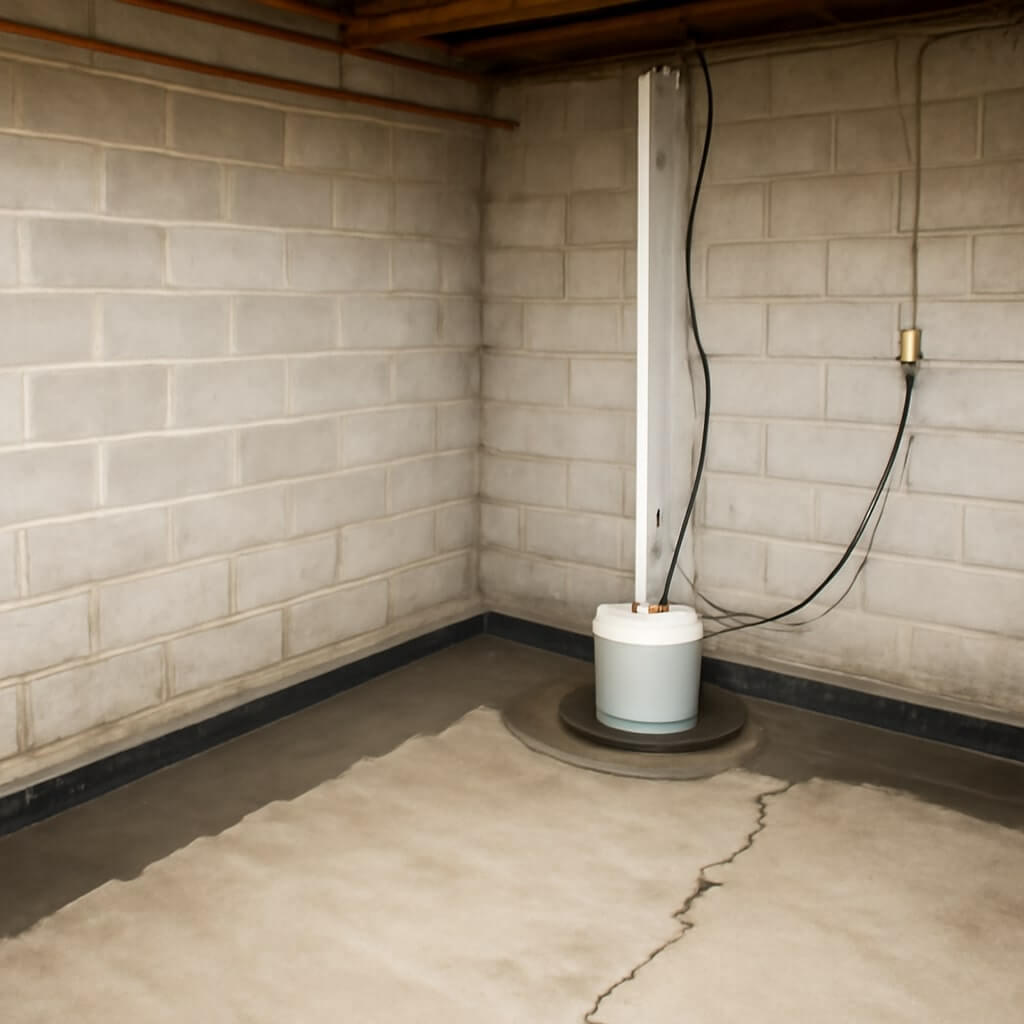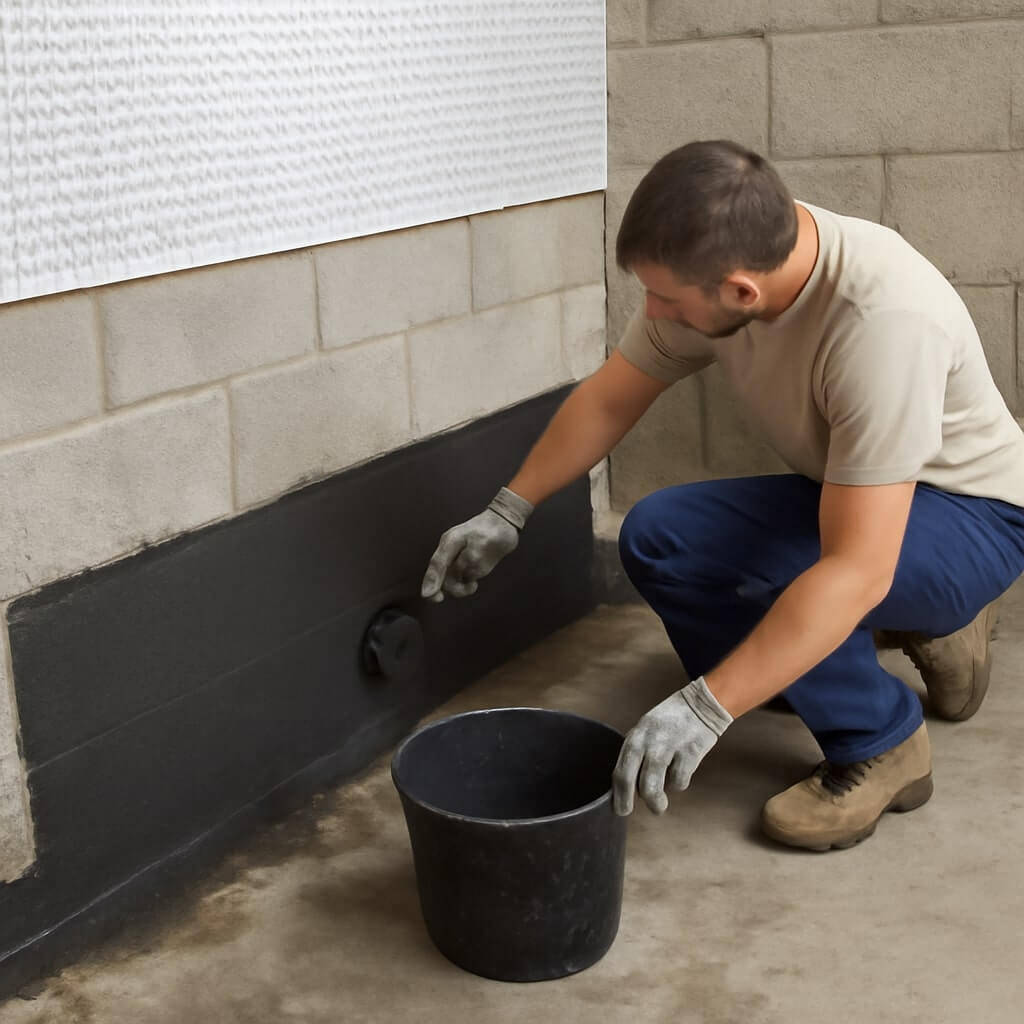
7 Key Benefits of Basement Waterproofing in Brooklyn NY
If you own a home in Brooklyn, you’ve probably noticed the challenges that come with a damp basement. While it might seem like a minor issue, waterproofing can offer significant benefits. Not only does it protect your property from water damage, but it also enhances your living space and overall health. Curious about how these advantages can transform your home and lifestyle? Let’s explore the key benefits of basement waterproofing.
Key Takeaways
- Protects your home from water damage, preventing mold growth and structural deterioration in Brooklyn’s humid climate.
- Increases property value by enhancing market appeal and attracting buyers with a secure, waterproofed basement.
- Improves indoor air quality by reducing allergens and moisture, promoting a healthier living environment for families.
- Transforms basements into usable spaces for gatherings or home offices, enhancing overall livability and functionality.
- Offers long-term cost savings by minimizing repair costs and improving energy efficiency, leading to lower utility bills.
Protects Your Home From Water Damage
When you invest in basement waterproofing, you’re not just adding a layer of protection; you’re safeguarding your entire home from potential water damage.
Effective moisture control is essential for preventing issues like mold growth and structural deterioration. By implementing reliable drainage solutions, you guarantee that excess water is directed away from your foundation, minimizing the risk of leaks and flooding.
This proactive approach not only protects your belongings but also contributes to a healthier living environment. Ultimately, taking these steps helps maintain the integrity of your home, giving you peace of mind and a safe space for you and your family.
Increases Property Value
Waterproofing your basement not only protects your home but also enhances its market appeal.
Buyers are more attracted to properties with assured structural integrity, knowing they won’t face water damage issues down the line.
Enhanced Market Appeal
Investing in basement waterproofing can greatly enhance your property’s market appeal, making it more attractive to potential buyers.
A dry, mold-free basement boosts curb appeal, showcasing a well-maintained home. Buyers are increasingly looking for properties with fewer hidden issues, and a waterproof basement signals that you’ve taken proactive steps to protect your investment.
This not only increases buyer interest but also sets your property apart in a competitive market. With a reliable, waterproof basement, you’re not just selling a house; you’re offering peace of mind to prospective homeowners, which can markedly elevate your property’s overall value.
Structural Integrity Assurance
A solid foundation is essential for any home, and ensuring your basement is waterproofed plays a key role in maintaining its structural integrity.
When you invest in waterproofing, you enhance foundation stability and provide vital structural reinforcement. This not only safeguards your home but also boosts its value.
Consider these benefits:
- Prevents water damage and mold growth.
- Reduces the risk of foundation cracks.
- Maintains a dry environment, promoting healthier air quality.
- Protects your investment, ensuring long-term property integrity.
Long-term Investment Security
When you think about your home’s value, remember that a dry, well-maintained basement can greatly enhance your property’s appeal.
Investing in basement waterproofing isn’t just about preventing moisture; it’s a smart financial decision. An investment analysis often shows that homes with waterproofed basements command higher prices on the market. Buyers appreciate the assurance of a safe, functional space, which translates to increased demand.
Additionally, the financial benefits extend beyond resale; a dry basement reduces maintenance costs over time. By choosing to waterproof your basement, you’re not just protecting your home—you’re securing your investment for the future.
Enhances Indoor Air Quality
When you waterproof your basement, you’re not just protecting your home from water damage; you’re also enhancing the air quality inside it.
By reducing mold growth and minimizing allergens, you’ll create a healthier environment for you and your family.
Plus, improved ventilation efficiency means fresher air circulates throughout your living spaces.
Reduces Mold Growth
Mold thrives in damp environments, making effective basement waterproofing essential for maintaining a healthy home.
By investing in waterproofing, you’re not just protecting your basement; you’re also enhancing your indoor air quality through mold prevention and humidity control.
Here’s how it helps:
- Prevents moisture accumulation – Keeping your basement dry stops mold from taking root.
- Reduces humidity levels – Controlling humidity makes it harder for mold to grow.
- Limits odor – A dry basement eliminates musty smells linked to mold.
- Promotes healthier air – Improved air quality leads to a more comfortable living environment.
Minimizes Allergens Presence
A damp basement doesn’t just encourage mold; it also invites a host of allergens that can affect your indoor air quality.
When you waterproof your basement, you reduce allergen sources like dust mites, pet dander, and mildew, creating a healthier environment.
By preventing moisture buildup, you help your air filtration system work more effectively, trapping those pesky allergens before they spread throughout your home.
This means you can breathe easier and enjoy a more comfortable living space.
Investing in basement waterproofing is a practical step toward minimizing allergens and enhancing your overall indoor air quality.
Improves Ventilation Efficiency
Improving your basement’s waterproofing not only protects against moisture but also enhances ventilation efficiency, which is essential for maintaining good indoor air quality.
When you invest in proper waterproofing, you boost your ventilation systems’ effectiveness, leading to better air circulation.
Here’s how it helps:
- Reduces humidity levels.
- Prevents mold growth.
- Enhances airflow throughout your home.
- Improves energy efficiency of HVAC systems.
With improved ventilation, you’ll enjoy a fresher, healthier living space, free from stale air and allergens.
Make your basement a key player in promoting ideal indoor air quality for you and your family.
Prevents Mold and Mildew Growth
When you waterproof your basement, you greatly reduce the chances of mold and mildew taking hold in your home.
Moisture is their best friend, and by controlling it, you can implement effective mold prevention strategies. A dry environment discourages their growth, saving you from costly mildew removal techniques later on.
Regularly checking for leaks and ensuring proper drainage can further enhance your efforts. Plus, a waterproofed basement promotes better indoor air quality, making your living space healthier.
Reduces Energy Costs
By eliminating excess moisture from your basement, waterproofing can considerably cut your energy costs.
When your basement stays dry, it enhances energy efficiency, leading to significant cost savings.
Here’s how:
- Improved Insulation: A dry basement maintains better insulation, reducing heating and cooling needs.
- Decreased HVAC Strain: Less moisture means your HVAC system works less, prolonging its lifespan.
- Lower Energy Bills: With efficient energy use, you’ll notice a drop in monthly utility bills.
- Increased Comfort: A stable environment keeps your home comfortable year-round, avoiding temperature fluctuations.
Investing in waterproofing pays off!
Provides a Safe and Usable Space
A waterproofed basement not only protects your home from water damage but also transforms the space into a safe and usable area.
Imagine turning that damp, cluttered room into a finished basement where your family can gather for movie nights or where you can create a home office.
With proper waterproofing, you can enjoy a functional space without the worry of mold or structural damage. This makes your basement a valuable extension of your home, increasing its overall livability and functionality.
Offers Peace of Mind
Peace of mind comes naturally when you know your basement is protected from water damage.
With effective waterproofing, you can enjoy peaceful living and stress relief, knowing your home is secure.
Imagine:
- No more worrying about mold growth.
- Increased air quality throughout your home.
- Assurance that your belongings are safe.
- A dry space for family gatherings or storage.
These benefits not only enhance your living environment but also reduce anxiety.
When you invest in basement waterproofing, you’re investing in your peace of mind, allowing you to focus on what truly matters—creating memories in a comfortable, dry space.
Conclusion
To sum up, investing in basement waterproofing in Brooklyn, NY, isn’t just about protecting your home; it’s about enhancing your entire living experience. By preventing water damage and mold growth, you create a safer, healthier environment for your family. Plus, you boost your property value and transform your basement into a functional space. With improved air quality and reduced energy costs, you’ll enjoy long-term savings and peace of mind. Don’t wait—make your home a better place today!

5 Signs Your Basement Needs Waterproofing in Alexandria MN?
If you live in Alexandria, MN, and notice visible water stains on your basement walls, it’s time to take action. These stains can indicate underlying moisture problems that could lead to serious structural issues. You might also encounter musty odors or mold growth, both of which can impact your health. Understanding these warning signs is essential to protecting your home and investment. Curious about the other indicators that suggest your basement needs waterproofing?
Key Takeaways
- Visible water stains on walls and ceilings indicate potential leaks or inadequate drainage needing immediate attention.
- Musty odors or mold growth signal moisture problems that can affect air quality and health.
- Cracks in walls or floors may threaten structural integrity and suggest underlying moisture issues.
- Increased humidity levels can lead to mold growth and structural damage, necessitating moisture control measures.
- Puddles or water accumulation in the basement indicate poor drainage or high groundwater levels that require prompt identification and action.
Visible Water Stains on Walls and Ceilings
Visible water stains on walls and ceilings are often the first indicators of potential moisture issues in your basement. Ignoring these stains can lead to serious water damage and foundation issues.
When you see discoloration, it’s essential to act quickly. These stains may signify underlying problems such as leaks or inadequate drainage. If left unaddressed, moisture can compromise your home’s structure and lead to costly repairs.
Musty Odors or Mold Growth
If you notice musty odors or see mold growth in your basement, it’s a clear sign of moisture problems that shouldn’t be ignored.
Mold thrives in damp environments, posing health risks and damaging your home. To tackle this issue, prioritize mold prevention strategies, such as improving ventilation and utilizing dehumidifiers.
Effective odor removal methods can also help eliminate the smell associated with mold. If these odors persist despite your efforts, consider professional waterproofing solutions to address the underlying moisture issues.
Taking action now will safeguard your basement and enhance your living space’s overall air quality. Don’t wait—act today!
Cracks in Walls or Floors
Cracks in walls or floors can serve as alarming indicators of underlying moisture issues in your basement. These fissures not only threaten wall integrity but also signal potential structural damage. If you notice cracks, it’s crucial to address them promptly.
- Inspect for size and direction of cracks.
- Monitor for new cracks or widening existing ones.
- Assess if cracks are accompanied by water stains.
Ignoring these signs can lead to more severe problems down the line.
Don’t wait until it’s too late; proactive waterproofing can save you from costly repairs and guarantee your basement remains safe and secure.
Increased Humidity Levels
As humidity levels rise in your basement, you may start to notice a musty odor or increased condensation on windows and surfaces. High humidity can lead to mold growth and structural damage, making humidity control essential. Installing moisture barriers can help reduce humidity and protect your home.
| Humidity Level | Symptoms | Solutions |
|---|---|---|
| 30-50% | Comfortable | Regular ventilation |
| 51-60% | Musty odor | Dehumidifiers |
| 61-70% | Condensation | Install moisture barriers |
| 71-80% | Mold growth risk | Improve drainage |
| 81%+ | Serious damage risk | Professional waterproofing |
Puddles or Water Accumulation in the Basement
High humidity levels can often lead to more severe issues, such as puddles or water accumulation in your basement.
If you notice water pooling, it’s essential to identify moisture sources and address them promptly. Ignoring these signs can result in costly damage.
Consider these factors:
- Poor water drainage: Inefficient systems can cause excess water to seep in.
- Cracks in walls or floors: These can be entry points for moisture.
- High groundwater levels: Seasonal changes can elevate water tables and lead to leaks.
Taking action now can protect your home from structural damage and mold growth.
Don’t wait—invest in waterproofing solutions today!
Conclusion
If you notice any of these signs in your basement, it’s essential to act quickly. Addressing visible water stains, musty odors, cracks, high humidity, or puddles can prevent further damage and protect your home’s structural integrity. Don’t wait for minor issues to escalate into costly repairs. Investing in professional waterproofing services can safeguard your living space and improve your overall indoor air quality. Take the necessary steps today to guarantee a dry, healthy environment in your basement.

Common Mistakes in Fieldstone Basement Waterproofing?
When it comes to fieldstone basement waterproofing, many homeowners make essential mistakes that can compromise their efforts. Ignoring proper drainage systems or using the wrong sealing materials can lead to serious water intrusion issues. Additionally, neglecting surface preparation and ventilation needs can exacerbate problems over time. Understanding these common pitfalls is vital for effective waterproofing. Let’s explore these missteps and how you can avoid them for a more resilient basement.
Key Takeaways
- Failing to customize waterproofing solutions for fieldstone basements can lead to inadequate protection against moisture intrusion and damage.
- Neglecting surface cleaning before applying sealants undermines adhesion, resulting in premature seal failure and water leaks.
- Using incompatible or low-quality sealing materials can significantly compromise the effectiveness of waterproofing efforts.
- Overlooking regular inspections for cracks and gaps can allow small issues to escalate into major water intrusion problems.
- Inadequate ventilation in fieldstone basements can trap moisture, increasing the risk of mold growth and structural damage.
Ignoring the Importance of Proper Drainage
One of the most critical factors in effective basement waterproofing is proper drainage.
You need to guarantee that your drainage systems are strategically placed to manage water flow away from your foundation. Neglecting this aspect can lead to water accumulation, causing leaks and structural damage.
Ensure your drainage systems are strategically positioned to direct water away from your foundation, preventing leaks and structural damage.
Install sump pumps and French drains to facilitate ideal water movement. Regularly inspect and maintain these systems to prevent blockages that could impede drainage.
By prioritizing proper drainage, you greatly reduce the risk of water-related issues, protecting your basement and maintaining the integrity of your home.
Don’t underestimate the importance of effective water management.
Using Inappropriate Sealing Materials
Choosing the right sealing materials is essential for effective basement waterproofing, as using inappropriate options can lead to significant problems down the line.
Here are four common mistakes to avoid:
- Using incompatible materials that don’t bond well with your foundation.
- Ignoring the specific sealing techniques recommended for your basement type.
- Selecting low-quality sealants that degrade quickly under moisture exposure.
- Overlooking manufacturer guidelines, which can compromise effectiveness.
Neglecting to Clean the Surface Before Sealing
Even with the right sealing materials, neglecting to clean the surface before sealing can undermine your waterproofing efforts.
Proper surface preparation is essential; dirt, dust, and debris can prevent the sealant from adhering effectively. Before applying any sealing techniques, thoroughly scrub the surface to remove contaminants.
For best results, use a pressure washer or a stiff brush along with a suitable cleaning solution. Allow the surface to dry completely before proceeding with sealing.
Skipping this critical step can lead to premature failure of the seal and potential water intrusion, negating your investment in waterproofing solutions.
Failing to Address Cracks and Gaps
When waterproofing your basement, you can’t overlook small cracks and gaps in the foundation.
Even minor issues can lead to significant water intrusion if left unaddressed.
Make it a priority to inspect and seal these vulnerabilities to guarantee a dry environment.
Ignoring Small Cracks
Small cracks and gaps in your basement might seem insignificant, but neglecting them can lead to major problems over time.
Effective crack detection is essential to maintaining your basement’s integrity. Address these issues promptly using the right repair methods. Here’s what you should know:
- Inspect regularly for new cracks or changes in existing ones.
- Use epoxy or polyurethane injections for small cracks.
- Seal gaps with appropriate caulking to prevent moisture intrusion.
- Monitor humidity levels to reduce the risk of further cracking.
Overlooking Foundation Gaps
Although it may be easy to dismiss foundation gaps as minor issues, overlooking them can lead to significant structural problems in your basement. Regular foundation inspections are essential for identifying these gaps. If left untreated, they can allow moisture and pests to invade your space. Implementing effective gap sealing techniques can prevent future complications.
| Issue | Solution |
|---|---|
| Visible Cracks | Professional Inspection |
| Water Infiltration | Gap Sealing |
| Pest Access | Reinforce Gaps |
Overlooking Ventilation Needs
Neglecting proper ventilation in your basement can lead to significant moisture issues, compromising the effectiveness of any waterproofing efforts.
Proper ventilation in your basement is crucial; neglecting it can cause moisture problems that undermine waterproofing efforts.
To guarantee adequate air circulation, consider these key factors:
- Install ventilation systems that effectively remove humid air.
- Use exhaust fans to help maintain airflow, especially in high-moisture areas.
- Incorporate passive vents to allow natural air exchange.
- Monitor humidity levels regularly to adjust your ventilation strategy as needed.
Skipping Pre-Waterproofing Inspections
Proper ventilation plays an essential role in maintaining a dry basement, but skipping pre-waterproofing inspections can undermine your efforts.
Conducting these inspections offers significant pre-inspection benefits, such as identifying existing moisture issues and potential vulnerabilities. This proactive approach can save you from costly repairs down the line.
While you may hesitate due to inspection costs, the investment is minimal compared to the expenses associated with water damage.
By taking the time for thorough inspections, you guarantee a more effective waterproofing strategy, leading to a healthier, drier basement environment.
Don’t overlook this vital step in your waterproofing process.
Miscalculating the Water Table Levels
When you miscalculate water table levels, you risk implementing ineffective waterproofing solutions that can lead to significant issues in your basement.
Understanding groundwater levels is essential for proper waterproofing. Here are key points to keep in mind:
- Assess Local Water Table: Determine average seasonal fluctuations in your area.
- Soil Composition: Analyze soil types as they affect drainage and water retention.
- Elevation: Reflect on the elevation of your basement relative to the water table.
- Weather Patterns: Monitor rainfall and snowmelt, as they influence groundwater levels.
Taking these factors into account can prevent costly mistakes and protect your basement from water damage.
Rushing the Drying Process
Rushing the drying process in basement waterproofing can lead to significant issues.
Proper curing is essential for ensuring materials bond effectively, while incomplete drying raises the risk of mold and structural damage.
Employing effective drying techniques can mitigate these risks and enhance the longevity of your waterproofing efforts.
Importance of Proper Curing
Curing is a critical phase in the basement waterproofing process, as it directly affects the integrity and effectiveness of the materials used.
Rushing this process can compromise your efforts. Here’s why proper curing matters:
- Cure Time: Allow sufficient time for materials to set properly.
- Moisture Control: Control moisture levels to prevent premature drying.
- Structural Integrity: Guarantee the bond between materials is solid.
- Long-Term Durability: A well-cured system enhances longevity.
Risks of Incomplete Drying
Proper curing sets the foundation for a successful waterproofing project, but the risks of incomplete drying can undermine that effort.
Rushing the drying process can lead to moisture retention, which fosters mold growth and compromises structural integrity. If you don’t allow adequate time for drying, trapped moisture can weaken your waterproofing materials, resulting in costly repairs down the line.
Utilizing improper drying techniques may further exacerbate the issue, leaving your basement vulnerable. Always prioritize thorough drying to guarantee your waterproofing solution is effective and long-lasting.
Taking the time to properly dry can save you significant headaches in the future.
Techniques for Effective Drying
While it might seem tempting to speed up the drying process to move on to the next phase of your basement waterproofing project, doing so can lead to significant setbacks.
Instead, utilize effective drying methods and moisture control techniques to guarantee thorough drying. Consider these steps:
- Ventilation: Increase air circulation using fans or open windows.
- Dehumidification: Employ dehumidifiers to remove excess moisture from the air.
- Heating: Use heaters to raise the temperature and promote evaporation.
- Moisture Monitoring: Regularly check humidity levels to gauge progress.
Taking your time with drying will prevent future complications.
Assuming One Solution Fits All Situations
Many homeowners mistakenly believe that one waterproofing solution can effectively address all basement issues, but this assumption can lead to inadequate protection.
Each basement is unique, requiring customized solutions based on specific conditions such as soil type, water table levels, and foundation design. An individualized assessment is essential to identify the most effective methods for your situation.
Relying on a one-size-fits-all approach can leave you vulnerable to water damage, mold growth, and structural issues. To guarantee long-lasting results, consult professionals who can tailor a waterproofing strategy that meets your basement’s specific needs and challenges.
Conclusion
In conclusion, avoid common mistakes in fieldstone basement waterproofing by prioritizing proper drainage, selecting compatible sealing materials, and thoroughly cleaning surfaces. Address all cracks and gaps, and guarantee adequate ventilation to prevent humidity issues. Don’t skip pre-waterproofing inspections or miscalculate water table levels, and allow sufficient drying time. Remember, a customized approach is essential; one solution won’t fit every situation. By being diligent, you can achieve effective and long-lasting waterproofing for your basement.

5 Proven Tactics to Attract Basement Waterproofing Leads
If you’re looking to boost your basement waterproofing business, there are key tactics that can set you apart from the competition. It’s not just about having a great service; you need a strategic approach to attract quality leads. From optimizing your online presence to building trust with clients, each step plays an essential role. Ready to explore these proven tactics? Let’s plunge into how you can implement them effectively.
Key Takeaways
- Optimize your website with SEO strategies to improve visibility and attract organic traffic seeking basement waterproofing solutions.
- Utilize targeted social media advertising to reach potential clients in specific geographic areas, showcasing your expertise and services.
- Share authentic customer testimonials and compelling case studies to build trust and credibility with prospective leads.
- Promote free inspections and assessments to entice potential clients, using local advertising to generate interest and urgency.
- Network with local real estate professionals and contractors to establish partnerships that can lead to valuable referrals and collaborations.
Optimize Your Online Presence With SEO Strategies
In today’s digital landscape, if you want to attract more leads for your basement waterproofing business, optimizing your online presence with effective SEO strategies is essential.
Start by using reliable SEO tools to analyze your website’s performance and identify areas for improvement. Conduct thorough keyword research to discover what potential customers are searching for.
Focus on incorporating these keywords naturally into your website content, blog posts, and meta descriptions. This won’t only enhance your visibility in search engine results but also position you as a trusted authority in basement waterproofing.
Take these steps, and watch your leads grow!
Leverage Social Media for Targeted Advertising
While many businesses overlook the power of social media, leveraging these platforms for targeted advertising can greatly boost your basement waterproofing leads. By focusing on specific demographics, you can reach homeowners who need your services.
Consider these strategies:
- Create engaging content that showcases your expertise.
- Utilize targeted ads to reach specific geographic areas.
- Experiment with video testimonials to draw in potential clients.
- Engage with local community groups to build awareness.
- Track your ad performance to refine your approach.
Don’t miss out on the opportunity social platforms offer; targeted ads can turn casual browsers into loyal customers!
Build Trust With Customer Testimonials and Case Studies
Harnessing the power of customer testimonials and case studies can greatly enhance your credibility in the basement waterproofing industry.
When potential clients see genuine customer feedback, they’re more likely to trust your services. Share compelling success stories that showcase how you’ve transformed damp basements into dry, safe spaces.
Highlight specific challenges you faced and how you overcame them. Use quotes from satisfied customers to add authenticity.
By presenting real-life experiences, you’ll create a strong emotional connection and encourage prospects to reach out for their own solutions.
Trust is key, and testimonials are your best tool to build it.
Offer Free Inspections and Assessments
Offering free inspections and assessments not only attracts potential clients but also demonstrates your commitment to their needs. By promoting free consultations, you can build trust and showcase your expertise.
Consider these effective strategies:
- Highlight your inspection promotions on social media
- Share success stories from past assessments
- Use eye-catching flyers in your local area
- Partner with real estate agents to spread the word
- Offer limited-time deals to create urgency
These tactics can draw in leads enthusiastic for solutions.
When you provide valuable insights upfront, you pave the way for lasting relationships and successful projects.
Network With Local Real Estate Professionals and Contractors
Building strong relationships with local real estate professionals and contractors can greatly enhance your basement waterproofing business. These real estate partnerships can lead to valuable contractor referrals, driving more leads your way. Attend networking events, join local associations, and collaborate on projects to build trust and visibility.
| Action | Benefit |
|---|---|
| Attend Networking Events | Meet potential partners |
| Offer Exclusive Deals | Attract referrals |
| Collaborate on Projects | Showcase your expertise |
| Share Success Stories | Build credibility |
Conclusion
By implementing these five proven tactics, you can effectively attract quality leads for your basement waterproofing business. Optimizing your online presence, leveraging social media, building trust through testimonials, offering free inspections, and networking with local professionals will set you apart from the competition. Don’t wait—start using these strategies today to grow your client base and establish lasting relationships. With the right approach, your business can thrive and help homeowners protect their valuable investments.

5 Reasons to Invest in Basement Waterproofing in Johnson City
Investing in basement waterproofing in Johnson City is a smart move for homeowners. It protects your home’s structural integrity and boosts its value, making it more attractive to potential buyers. Plus, it prevents mold and mildew growth, ensuring a healthier living environment. By transforming your basement into usable space, you can enjoy added functionality. Curious about how these benefits can save you money on future repairs? Let’s explore the key reasons further.
Key Takeaways
- Protect your home’s structural integrity by preventing water seepage that can cause foundation damage and costly repairs.
- Enhance your home’s value; a waterproofed basement is a major selling point for potential buyers.
- Prevent mold and mildew growth by creating a dry environment, ensuring a safer home for your family.
- Increase usable living space by transforming damp areas into functional rooms like family rooms or home offices.
- Save money on future repairs by stopping moisture before it leads to expensive remediation and foundation fixes.
Protect Your Home’s Structural Integrity
When water seeps into your basement, it doesn’t just create a damp environment; it threatens your home’s structural integrity.
This moisture can weaken foundation stability, leading to cracks and shifts that compromise your entire property. Over time, this damage can escalate, jeopardizing your investment and reducing property longevity.
By investing in basement waterproofing, you’re taking proactive steps to safeguard your home. Keeping your basement dry not only protects your foundation but also prevents costly repairs down the line.
Don’t wait for small leaks to become big problems; prioritize your home’s health and guarantee its structural integrity today.
Enhance Your Home’s Value
Investing in basement waterproofing not only protects your home’s structural integrity but also enhances its overall value.
A dry, well-maintained basement greatly boosts your home aesthetics and creates a more inviting space. Potential buyers often seek homes that are free from water damage and mold concerns, so waterproofing can elevate your property appeal.
A waterproofed basement enhances your home’s beauty and attracts buyers by eliminating concerns over water damage and mold.
When you decide to sell, a waterproofed basement can be a major selling point, making your home stand out in a competitive market.
Ultimately, this investment not only safeguards your property but also contributes to a higher resale value, ensuring a wise financial decision for you.
Prevent Mold and Mildew Growth
Humidity and moisture can quickly lead to mold and mildew growth in your basement, posing health risks to your family.
Investing in basement waterproofing is essential for effective mold prevention and mildew control. By sealing cracks and ensuring proper drainage, you create a dry environment that discourages these harmful fungi.
Not only does this enhance your home’s safety, but it also protects your belongings from damage.
Don’t wait until mold becomes a problem; act now to safeguard your home and loved ones. A dry basement is key to a healthier living space, so prioritize waterproofing today.
Increase Usable Living Space
A waterproof basement opens up valuable living space in your home.
By investing in basement waterproofing, you can transform that damp, unused area into a finished basement that meets your needs.
Imagine creating a cozy family room or a stylish home office where you can work comfortably without distractions.
This added space not only enhances your lifestyle but also increases your home’s value.
Plus, a well-finished basement can serve as a welcoming guest suite or a play area for your kids.
Don’t let water issues hold you back from maximizing your home’s potential—invest in waterproofing today!
Save Money on Future Repairs
Transforming your basement into usable living space not only enhances your home’s value but also helps you save money on future repairs.
By investing in basement waterproofing, you can achieve significant cost savings through effective repair prevention. Here’s how:
- Avoid Mold Growth: Preventing moisture stops mold, which can lead to costly remediation.
- Structural Integrity: Waterproofing protects your foundation from water damage, reducing repair expenses.
- Energy Efficiency: Dry basements improve insulation, lowering utility bills.
- Increased Home Value: A waterproofed basement boosts your home’s market appeal, ensuring a better return on investment.
Make the smart choice today!
Conclusion
Investing in basement waterproofing is a smart move for any homeowner in Johnson City. By protecting your home’s structural integrity and enhancing its value, you’re not just safeguarding your investment but also creating a healthier living environment. Plus, transforming your basement into usable space and preventing costly repairs down the line makes it a win-win. Don’t wait for water damage to become a problem—take action now and enjoy the long-term benefits of a dry, secure basement!

Essential Tips for Effective Basement Waterproofing in Jackson
When it comes to basement waterproofing in Jackson, you’ve got to assess your basement’s vulnerabilities first. Look for cracks in the foundation and consider how water flows around your property. Choosing the right waterproofing method is essential, as it can prevent costly damage down the line. But that’s just the beginning; understanding the various systems and techniques available can make all the difference in keeping your basement dry. Let’s explore these strategies further.
Key Takeaways
- Inspect your basement foundation regularly for cracks and gaps to prevent moisture intrusion.
- Ensure proper grading around your home’s exterior to direct water away from the foundation.
- Choose the right waterproofing method, balancing DIY options with professional services based on project complexity.
- Install an interior drainage system like a French drain to effectively manage water accumulation.
- Maintain humidity levels below 60% with dehumidifiers and ensure proper ventilation to prevent mold growth.
Assessing Your Basement’s Vulnerability
How can you determine if your basement is vulnerable to water intrusion? Start with a thorough vulnerability assessment.
Inspect the foundation for cracks and gaps, which may allow moisture sources, like rainwater or groundwater, to seep in. Check for improper grading around the exterior, ensuring water drains away from your home.
Examine the interior for signs of dampness, mold, or mildew, which indicate moisture problems. Don’t forget to inspect windows and doors for seal integrity.
Choosing the Right Waterproofing Method
When choosing the right waterproofing method, you’ll need to weigh interior solutions against exterior options.
Consider whether you want to tackle the project yourself or hire professionals, as both paths have distinct advantages and challenges.
Understanding these factors will help you make an informed decision that best suits your basement’s needs.
Interior vs. Exterior Solutions
Which waterproofing method is best for your basement: interior or exterior solutions?
Interior barriers, such as sealants and drainage systems, manage moisture after it enters your space, making them effective for minor issues. However, they don’t address the root cause.
On the other hand, exterior membranes prevent water from reaching your foundation by creating a barrier outside. This method is proactive and often more effective for severe water problems.
Consider your basement’s specific needs, moisture levels, and potential sources of water intrusion when deciding, as choosing the right method can save you from costly repairs down the line.
DIY vs. Professional Services
Choosing between DIY methods and professional services for basement waterproofing involves evaluating your skills, the severity of the moisture issue, and the complexity of the solutions.
DIY techniques, such as applying sealants or installing drainage systems, can be cost-effective but require a solid understanding of the underlying problems.
However, if you’re facing significant water intrusion or structural concerns, professional services may be necessary.
While professional costs can be higher, they often include warranties and expertise that guarantee long-lasting results.
Weigh your options carefully to determine the best approach for your situation and avoid costly mistakes down the line.
Installing Interior Drainage Systems
When you’re installing an interior drainage system, it’s essential to understand the different types available, such as French drains and sump pumps, to choose the best fit for your basement.
The installation process involves several key steps, including proper placement of the drainage system and ensuring effective water flow.
Let’s explore how to execute this process efficiently to safeguard your home from water damage.
Types of Drainage Systems
Installing an effective interior drainage system is essential for preventing water damage in your basement. There are various drainage system types to evaluate, each offering effective drainage solutions tailored to your needs.
The most common include French drains, which channel water away from your foundation, and sump pumps, which remove collected water. Interior drain tiles, installed along the perimeter, direct water to a sump pump for efficient removal.
Each system has its advantages, so assess your basement’s specific conditions. Choosing the right combination can greatly enhance your basement’s waterproofing effectiveness, ensuring a dry and safe environment.
Installation Process Steps
To guarantee a successful installation of an interior drainage system, you’ll want to follow a series of methodical steps that confirm effective water management.
First, gather your installation tools, including a jackhammer, trowel, and level.
Next, excavate a trench around the perimeter of your basement, confirming it’s deep enough for your chosen waterproofing materials.
Install the drainage pipe at the trench’s base, sloping it towards the sump pit.
Fill the trench with gravel for drainage support, then cover it with concrete to finish.
Finally, test the system to verify proper water flow and seal any gaps to prevent leaks.
Sealing Cracks and Gaps
Although maintaining a dry basement is vital for your home’s integrity, sealing cracks and gaps is often overlooked. Proper crack sealing and gap filling prevent water infiltration, mold growth, and structural damage. Start by identifying cracks and gaps in walls and floors, then choose an appropriate sealant.
| Type | Application Method | Recommended Sealant |
|---|---|---|
| Hairline Cracks | Inject or apply sealant | Polyurethane caulk |
| Wide Cracks | Fill with foam | Expanding foam |
| Gaps | Use backer rod | Silicone sealant |
| Joints | Caulk seams | Acrylic latex caulk |
| Foundation Cracks | Inject epoxy | Epoxy sealant |
Invest time in this significant step to guarantee lasting protection.
Enhancing Exterior Grading and Drainage
Properly enhancing exterior grading and drainage is essential for preventing water from pooling around your foundation, which can lead to considerable moisture issues in your basement.
Start by confirming the ground slopes away from your home, ideally at a 2% grade. Explore landscaping solutions such as installing rain gardens or using decorative stones to direct water flow.
Additionally, consider drainage improvements like French drains or downspout extensions to channel rainwater away effectively. Regularly inspect and maintain these systems to guarantee they function correctly.
Utilizing Sump Pumps Effectively
How can you guarantee your sump pump operates at peak efficiency? First, make certain proper sump pump installation, placing the unit in the lowest area of your basement.
Regular sump pump maintenance is vital; check for clogs and test the pump monthly to confirm it activates correctly. Clean the sump pit and inspect the discharge line for blockages.
Additionally, consider installing a backup power source to keep it running during power outages. Don’t forget to replace the sump pump every 5-10 years, depending on usage.
Maintaining Humidity Levels
To maintain ideal humidity levels in your basement, it’s important to monitor and control moisture effectively.
Proper humidity control is vital for preventing mold and structural damage. Here are three key strategies for moisture management:
Effective humidity control is essential to avert mold growth and structural harm in your home.
- Use Dehumidifiers: Invest in a dehumidifier to remove excess moisture, keeping humidity levels below 60%.
- Ventilation: Guarantee proper ventilation by installing vents or exhaust fans, allowing air circulation to reduce dampness.
- Seal Cracks: Regularly inspect and seal any cracks in walls or floors to prevent moisture ingress.
Implementing these measures will safeguard your basement against humidity-related issues.
Regular Inspections and Maintenance
Although it may seem tedious, conducting regular inspections and maintenance of your basement is essential for long-term protection against moisture and structural damage. By performing routine checks, you can identify potential issues early, allowing you to implement preventive measures before they escalate. Schedule inspections quarterly and use the table below to guide your maintenance tasks.
| Task | Frequency |
|---|---|
| Inspect walls | Quarterly |
| Check gutters | Biannually |
| Test sump pump | Monthly |
| Seal cracks | As needed |
Staying proactive will save you time and money while ensuring a safe, dry basement.
Conclusion
By following these essential tips for basement waterproofing in Jackson, you can greatly reduce the risk of moisture damage in your home. Addressing vulnerabilities, choosing the right methods, and maintaining your drainage systems are vital steps. Don’t overlook the importance of sealing cracks and managing humidity levels. Regular inspections will help you stay ahead of potential issues, ensuring a dry, safe basement for years to come. Invest the time now to protect your home from water-related problems later.

What Steps Are Involved in Installing a Basement Waterproofing Drain Channel?
When it comes to installing a basement waterproofing drain channel, you need to follow a systematic approach to guarantee effectiveness. Start by evaluating potential water issues in your basement and gather the necessary tools and materials. It’s vital to plan the layout methodically before moving on to excavation. Each step builds on the previous one, and understanding the specifics will make a significant difference in the outcome. Let’s explore how to execute this process efficiently.
Key Takeaways
- Conduct a thorough moisture assessment to identify water sources and problem areas in the basement.
- Plan and excavate a channel, ensuring proper slope and clearance for effective drainage.
- Install the drain channel, using waterproofing materials and ensuring alignment with the slope.
- Test the system by simulating heavy rainfall to confirm drainage efficiency and performance.
- Schedule regular maintenance checks to monitor sealant integrity and system functionality over time.
Assessing the Basement for Water Issues
Before you start any waterproofing project, it’s essential to assess your basement for potential water issues.
Begin with a thorough moisture assessment to identify water sources like leaky pipes, cracks in walls, or condensation. Inspect the floors and walls for dampness or mold, as these can indicate underlying problems.
Check the grading around your home; improper slope can direct water towards your foundation. Pay attention to gutters and downspouts, ensuring they’re clear and directing water away.
Gathering Necessary Tools and Materials
After identifying potential water issues in your basement, the next step is gathering the necessary tools and materials for installing a waterproofing drain channel.
Start by creating a tools checklist, which should include a concrete saw, shovel, level, and trowel.
For material selection, you’ll need PVC drain pipes, gravel, and waterproof sealant. Confirm all materials are compatible with your specific drainage needs.
Double-check your inventory before beginning the installation process to avoid delays. Having the right tools and materials on hand will streamline your project and help confirm a successful installation of your basement waterproofing system.
Planning the Drain Channel Layout
As you begin planning the drain channel layout, it’s crucial to visualize how the system will route water away from your basement.
Start by evaluating your basement’s dimensions and identifying problem areas where water tends to collect. Consider the slope of your floor; water needs a clear path to flow into the channel.
Evaluate your basement’s dimensions and pinpoint water-collecting areas, ensuring a clear path for drainage.
Choose appropriate drain channel materials, such as PVC or concrete, based on durability and local building codes. Verify your layout accommodates any obstacles like support beams or utilities.
Finally, plan for proper drainage to an external outlet, keeping layout considerations in mind to maximize efficiency and effectiveness.
Excavating the Basement Floor
Before you start excavating the basement floor, prepare the area by clearing out any furniture and debris.
You’ll also need to remove the existing flooring to access the concrete slab beneath.
This preparation is essential for ensuring a smooth installation of the waterproofing drain channel.
Preparing the Area
To effectively prepare the area for a basement waterproofing drain channel, you’ll need to excavate the basement floor carefully.
Start by marking the intended path of the drain channel to guarantee accurate area preparation. Use a jackhammer or concrete saw to break through the existing floor, maintaining a consistent depth for maximum drainage.
Remove debris promptly to keep the work area clear. Confirm the excavated space slopes slightly toward the drain’s location, enhancing your waterproofing strategies.
Finally, check for any plumbing or electrical lines before proceeding further, as this will prevent potential damage during installation.
Removing Existing Flooring
Begin by carefully removing any existing flooring in the designated area where the drain channel will be installed.
Depending on the flooring materials, you may use different removal techniques. For tile, a chisel and hammer can effectively break the bond. For concrete, a jackhammer or sledgehammer may be necessary.
Make sure you wear safety gear to protect against debris. If dealing with carpet, use a utility knife to cut and pull it up easily.
Once the flooring is removed, clean the area thoroughly to prepare for excavation, making certain no debris obstructs the installation of the waterproofing drain channel.
Installing the Drain Channel
Installing the drain channel requires careful planning and execution to guarantee peak performance in waterproofing your basement.
First, choose the appropriate drain channel types based on your basement’s layout and water issues. Common options include interior and exterior channels.
Selecting the right drain channel type is crucial, considering your basement’s layout and specific water challenges.
Next, prepare the trench by digging to the necessary depth, ensuring it’s slightly sloped toward the outlet. Place waterproofing materials, such as gravel, at the bottom to promote drainage.
Carefully position the drain channel, aligning it with the slope. Finally, cover the channel with suitable flooring material, ensuring it’s flush and unobtrusive.
This setup will efficiently redirect water away from your basement.
Connecting to the Sump Pump
Once you’ve installed your drain channel, the next step is connecting it to the sump pump.
You’ll need to carefully select the sump pump’s location for peak efficiency and guarantee proper pipe connections to prevent leaks.
After installation, it’s vital to test the drainage system to confirm everything functions correctly.
Sump Pump Location Selection
When selecting the location for your sump pump, it’s crucial to take into account both efficiency and accessibility.
Ideally, you should place the sump pump in the lowest part of your basement, where water naturally collects. Consider different sump pump types—submersible pumps work well for deeper installations, while pedestal pumps suit shallower areas.
Confirm your sump pump placement allows for easy access for maintenance and inspections. Additionally, keep the pump away from any potential blockages, like furniture or storage items, to maintain peak functionality.
Proper positioning will maximize water removal and enhance your basement’s waterproofing system.
Proper Pipe Connections
To guarantee effective water removal, connecting the drainage pipes to the sump pump requires careful attention to detail. Start by selecting proper pipe materials like PVC or ABS, which resist corrosion. Ascertain you use secure pipe fittings to prevent leaks.
| Step | Description | Tools Needed |
|---|---|---|
| Cut Pipes | Measure and cut to length | Pipe cutter |
| Clean Edges | Remove debris from edges | Sandpaper |
| Fit Pipes | Connect pipes to fittings | PVC cement |
| Seal Joints | Apply sealant to all joints | Sealant applicator |
| Test Connection | Check for leaks | Water source |
Testing Drainage System
Testing the drainage system after connecting it to the sump pump is essential for guaranteeing effective water management in your basement.
Begin by filling the drain channel with water, observing the flow towards the sump pump. Verify the pump activates promptly, removing water efficiently.
Check for leaks at all connections and inspect the discharge line for proper water expulsion.
Regularly testing this system is imperative for ongoing drainage maintenance, preventing future water buildup.
Document any issues you encounter and address them immediately to maintain peak performance.
A fully functional drainage system safeguards your basement from moisture-related problems.
Backfilling and Compacting the Soil
After you’ve installed the drain channel and guaranteed proper grading, backfilling and compacting the soil becomes vital to restore stability and prevent future water issues.
Start by selecting appropriate drainage material, ensuring it’s free from debris for peak performance. Use effective soil compaction techniques, like mechanical compactors or hand tampers, to achieve the desired density.
Layer the backfill material evenly, compacting each layer thoroughly. This process minimizes voids and enhances drainage efficiency.
Sealing the Drain Channel
Once the soil has been properly compacted around the drain channel, sealing the channel itself is the next critical step in guaranteeing peak performance.
You’ll want to apply effective sealing techniques to prevent water intrusion. Begin by using high-quality waterproof materials, such as polyurethane sealants or epoxies, designed for basement applications.
Confirm the surfaces are clean and dry before application for ideal adhesion. Carefully follow the manufacturer’s instructions regarding curing times and environmental conditions.
Ensure surfaces are clean and dry for optimal adhesion, and adhere to the manufacturer’s guidelines for curing and environmental conditions.
Pay special attention to joints and changes, as these areas are often vulnerable. Proper sealing will enhance the longevity and efficiency of your waterproofing system.
Testing the System for Effectiveness
Before you can be confident in your basement waterproofing system, it’s essential to test its effectiveness under real conditions.
Start by simulating heavy rainfall or using a hose to direct water toward the drain channel. Observe the water flow and verify it directs towards the sump pump or drainage outlet efficiently.
Check the drainage efficiency by monitoring how quickly the water is removed from the area. If you notice pooling or slow drainage, adjustments may be necessary.
Proper testing confirms that your system performs effectively, preventing future water damage and guaranteeing long-term reliability in your basement waterproofing solution.
Conclusion
By following these steps to install a basement waterproofing drain channel, you can effectively manage moisture issues and protect your home. Assess your basement, gather the right tools, and plan your layout carefully. When you excavate and install the drain with proper slope, connect it to a sump pump, and seal everything securely, you’ll guarantee peak performance. Don’t forget to test the system and maintain it regularly for long-lasting effectiveness. Protecting your space starts with a solid drainage solution.

7 Signs You Need Basement Waterproofing in Blue Springs MO?
When it comes to maintaining your home in Blue Springs, you might overlook your basement until issues arise. Musty odors, water stains, and visible mold can indicate serious moisture problems lurking below. Additionally, cracks in foundation walls and high humidity levels should raise red flags. If you’ve noticed an increase in energy bills, it may be tied to these hidden issues. What other signs should you be on the lookout for?
Key Takeaways
- Musty odors in the basement indicate moisture issues that can lead to mold growth and require immediate attention.
- Water stains on walls and floors suggest moisture intrusion, needing prompt detection and repair to prevent further damage.
- Visible mold and mildew growth signal a damp environment, which poses health risks and necessitates immediate mold remediation.
- Cracks in foundation walls may indicate structural problems, making it essential to schedule a professional inspection for proper assessment and repair.
- Increased energy bills can be a sign of excessive humidity, impacting HVAC efficiency and highlighting the need for basement waterproofing solutions.
Musty Odors in the Basement
When you step into your basement and encounter a musty odor, it’s not just an unpleasant surprise; it often indicates underlying moisture issues.
Poor basement ventilation can trap humidity, creating a breeding ground for mold and mildew. These odor sources thrive in damp conditions, leading to that characteristic smell.
Inspect your basement for signs of moisture intrusion, such as leaks or condensation, which can worsen air quality.
Improving ventilation by adding exhaust fans or dehumidifiers can help mitigate odors and prevent future problems.
Addressing these issues promptly not only enhances comfort but also protects your home’s structural integrity.
Water Stains on Walls and Floors
Water stains on walls and floors are often a clear signal that moisture is making its way into your basement. These stains may indicate significant water damage, especially if they appear frequently or grow larger over time.
It’s essential to address these issues promptly, as persistent moisture can lead to structural problems. Use moisture detection methods to identify sources of water infiltration, like leaky pipes or groundwater seepage.
Don’t ignore these signs; they can escalate into costly repairs. By recognizing water stains early, you can take action to protect your home and maintain a dry, safe environment in your basement.
Visible Mold and Mildew Growth
After noticing water stains on your walls and floors, the appearance of visible mold and mildew growth is another alarming sign of moisture issues in your basement.
Mold thrives in damp environments, and its presence can lead to serious health problems. You should implement mold prevention strategies like improving ventilation, using dehumidifiers, and sealing cracks.
For immediate concerns, mildew treatment options include specialized sprays and cleaning solutions to eliminate the spores.
Ignoring this issue can cause more extensive damage and costly repairs, so addressing mold and mildew promptly is essential for maintaining a safe and healthy basement environment.
Cracks in Foundation Walls
Cracks in foundation walls can signal serious structural problems that may jeopardize the integrity of your home. If you notice these cracks, it’s vital to schedule a foundation inspection promptly.
Ignoring them can lead to worsening damage and costly repairs down the line. During the inspection, professionals will assess the cracks’ size and location to determine their cause.
Based on their findings, they may recommend crack repair solutions, such as epoxy injections or wall anchors, to stabilize your foundation. Addressing these issues early can prevent further complications and guarantee your home remains safe and structurally sound.
Excessive Humidity Levels
If you notice musty odors or see condensation forming on surfaces, it’s likely a sign of excessive humidity in your basement.
High humidity levels not only create an uncomfortable environment but also pose health risks like mold growth and respiratory issues.
Addressing this moisture is vital, and there are effective solutions available to help you maintain a healthier space.
Symptoms of High Humidity
Have you noticed a sticky feeling in the air or a persistent mustiness in your basement? These are common symptoms of high humidity levels.
When humidity spikes, it creates an environment ripe for mold and mildew, signaling that your humidity control measures may be failing. You might also see condensation on windows or walls, indicating excessive moisture.
Check for water stains or peeling paint—these are clear signs that moisture barriers are compromised. If you’re experiencing these issues, it’s essential to address them promptly to prevent further damage and maintain a healthy, dry basement.
Don’t wait; take action now!
Health Risks Involved
While you might appreciate a warm and humid day outside, excessive humidity levels in your basement can pose serious health risks. Mold exposure thrives in such conditions, leading to respiratory issues for you and your family. The spores released can trigger allergies, asthma attacks, and other health complications.
| Health Risk | Description |
|---|---|
| Mold Exposure | Can lead to allergic reactions |
| Respiratory Issues | Aggravates asthma and other conditions |
| Dust Mites | Thrive in humid environments |
| Structural Damage | Compromises air quality |
Addressing these risks is essential for a safe living environment.
Solutions for Excess Moisture
Excessive humidity levels in your basement can lead to serious health concerns, making it imperative to implement effective solutions for managing moisture.
Start by installing moisture barriers, which prevent water vapor from seeping through walls and floors. These barriers are essential in keeping your space dry and reducing humidity.
Additionally, consider drainage solutions like sump pumps and French drains to direct water away from your basement.
Proper ventilation also plays a fundamental role; use dehumidifiers to maintain ideal humidity levels and guarantee air circulation.
Pooling Water or Puddles
If you notice water pooling or forming puddles in your basement, it’s essential to assess the situation immediately.
This accumulation often points to underlying issues related to seasonal rain impacts or an ineffective drainage system.
Addressing these concerns promptly can prevent more significant damage and guarantee your space remains dry and safe.
Water Accumulation Areas
When you notice water pooling in specific areas around your basement, it’s crucial to take action, as this can indicate underlying issues with your waterproofing system.
Identifying these water accumulation areas helps prevent further damage. Here are key considerations:
- Check for poor soil grading – Confirm the ground slopes away from your foundation.
- Look for drainage improvements – Inspect gutters and downspouts for blockages.
- Assess landscaping – Verify plants and features aren’t directing water toward your basement.
- Monitor moisture levels – Use a moisture meter to detect hidden issues.
Addressing these factors can greatly enhance your basement’s waterproofing.
Seasonal Rain Impact
Seasonal rain can greatly exacerbate existing waterproofing challenges in your basement, especially when water pools or forms puddles in unexpected areas. This pooling can lead to significant moisture management issues, fostering mold growth and structural damage. Identifying these puddles early is essential to preventing more extensive problems.
| Signs of Pooling Water | Action Needed |
|---|---|
| Visible puddles | Assess drainage systems |
| Musty odors | Check for leaks |
| Damp walls | Inspect waterproofing |
| Mold growth | Consider professional help |
Addressing these signs promptly can safeguard your home against the impacts of seasonal rainfall.
Drainage System Efficiency
A well-functioning drainage system is essential for preventing pooling water and puddles in your basement. If you notice these issues, it’s time to evaluate your system and consider drainage improvement techniques.
Here are four signs that indicate you may need sump pump installation or other enhancements:
- Water accumulation in corners or along walls.
- Frequent dampness or musty odors in the basement.
- Mold growth or water stains on walls.
- Ineffective gutters that overflow during rain.
Addressing these concerns promptly can prevent costly damage and guarantee your basement remains dry and comfortable.
Don’t wait until it’s too late!
Increased Energy Bills
If you’ve noticed a spike in your energy bills, it might signal more than just rising utility rates; it could indicate underlying moisture problems in your basement.
Excess moisture can lead to poor energy efficiency, as your HVAC system struggles to maintain a comfortable temperature. This increased workload drives up your costs.
Conducting a cost analysis on your energy usage may reveal that addressing basement moisture issues could save you money long-term.
Ignoring these signs can result in higher bills and potential damage to your home, making it essential to contemplate basement waterproofing as a proactive solution.
Conclusion
If you’re noticing any of these signs in your basement, it’s essential to take action. Addressing musty odors, water stains, and visible mold can prevent more significant damage and costly repairs down the line. Don’t ignore cracks in your foundation or excessive humidity; these issues can compromise your home’s structural integrity. By investing in basement waterproofing, you’re not just protecting your property—you’re enhancing its value and ensuring a healthier living environment for you and your family.

3 Best Annapolis MD Contractors for Basement Waterproofing
If you’re facing issues with moisture in your basement, finding the right contractor is essential. In Annapolis, MD, three contractors stand out for their expertise in basement waterproofing. They offer tailored solutions and advanced techniques to protect your home from water damage. Each brings unique strengths to the table, ensuring you have options that best suit your needs. Let’s explore what makes these contractors the top choices for safeguarding your basement.
Key Takeaways
- A1 Basement Solutions offers tailored waterproofing services with high-quality materials, ensuring effective moisture control and lasting protection for Annapolis homes.
- Maryland Basement Waterproofing provides comprehensive inspections and custom solutions, focusing on identifying and preventing water entry points in your basement.
- DryPro Foundation Repair specializes in advanced drainage systems and sealing methods, offering detailed inspections to address unique moisture issues effectively.
- All three contractors ensure regular maintenance plans to sustain moisture control and prevent future water damage, enhancing the longevity of your basement.
- Choosing any of these contractors guarantees professional service, increased property value, and peace of mind regarding basement moisture problems.
Reliable Waterproofing Solutions: A1 Basement Solutions
When it comes to basement waterproofing, A1 Basement Solutions stands out as a top choice for homeowners in Annapolis, MD.
You’ll appreciate the A1 advantages, including their commitment to using advanced A1 techniques that guarantee lasting protection against water damage.
Their thorough assessments identify potential issues, allowing them to tailor solutions specifically for your basement’s needs.
Plus, their experienced team employs high-quality materials and innovative methods to prevent leaks and moisture buildup.
With A1, you’re not just getting a service; you’re investing in peace of mind, knowing your home is safeguarded from the elements for years to come.
Expert Services From Maryland Basement Waterproofing
Maryland Basement Waterproofing offers a thorough range of expert services designed to tackle all your basement water issues.
Their team guarantees effective moisture control and peace of mind through:
- Comprehensive basement inspection – They evaluate your basement to identify potential water entry points.
- Custom waterproofing solutions – Tailored strategies address specific needs based on inspection findings.
- Ongoing maintenance plans – Regular check-ups and adjustments keep your basement dry long-term.
With their expertise, you can trust that your basement will remain safe and dry, protecting your home from future water damage.
Don’t let moisture compromise your property—take action today!
Comprehensive Care by DryPro Foundation Repair
If you’re facing basement water issues, DryPro Foundation Repair offers detailed care that goes beyond standard solutions.
Their team conducts a thorough foundation inspection to identify the root causes of moisture problems. By understanding your unique situation, they tailor moisture control strategies that effectively prevent future issues.
From advanced drainage systems to effective sealing methods, DryPro prioritizes your home’s integrity. Their commitment to high-quality service guarantees you receive lasting results, allowing you to enjoy a dry, safe basement.
Trust DryPro to provide the expert care you need for a worry-free living environment, making your basement a functional space once again.
Conclusion
In summary, choosing the right contractor for basement waterproofing in Annapolis is essential for protecting your home. A1 Basement Solutions offers tailored assessments and high-quality materials, while Maryland Basement Waterproofing provides thorough inspections and customized solutions. DryPro Foundation Repair takes it a step further with advanced drainage systems and in-depth evaluations. By partnering with any of these reputable contractors, you can guarantee a dry, safe basement and peace of mind for years to come.

3 Trusted Contractors for Basement Waterproofing in Alnwick
If you’re facing moisture issues in your basement, finding the right contractor can make all the difference. In Alnwick, three trusted options stand out: ABC Waterproofing Solutions, Alnwick Basement Pros, and DryShield Contractors. Each brings unique strengths to the table, ensuring tailored solutions for your specific needs. Curious about what each contractor offers and how they can help protect your home from water damage? Let’s explore their standout features.
Key Takeaways
- ABC Waterproofing Solutions offers innovative techniques and tailored assessments for effective basement moisture protection using advanced products.
- Alnwick Basement Pros is a reliable partner specializing in moisture control and renovations, using quality materials for customized solutions.
- DryShield Contractors employs advanced techniques for long-term protection against leaks, ensuring customer satisfaction through quality workmanship.
- Consider contractors’ expertise, customer reviews, and range of services when selecting a waterproofing provider.
- Effective waterproofing enhances home value, prevents damage, and improves indoor air quality by reducing moisture-related issues.
ABC Waterproofing Solutions
When it comes to protecting your home from water damage, ABC Waterproofing Solutions stands out as a reliable choice.
They specialize in innovative waterproofing techniques designed to tackle basement moisture effectively. Their team of experts assesses your home’s unique needs, ensuring tailored solutions that prevent water infiltration.
With advanced products and methods, you’ll gain peace of mind knowing your basement is safeguarded against leaks and dampness.
Experience peace of mind with advanced waterproofing solutions that protect your basement from leaks and dampness.
Whether it’s interior drainage systems or exterior barriers, ABC Waterproofing Solutions has the expertise to keep your space dry and comfortable.
Trust them to enhance your home’s resilience against water-related issues.
Alnwick Basement Pros
If you’re looking for a dependable partner in basement waterproofing, Alnwick Basement Pros should be at the top of your list. They specialize in moisture control and can help you with essential basement renovations. Their experienced team focuses on delivering quality solutions tailored to your needs, ensuring a dry, safe space.
| Service | Benefits | Why Choose Us |
|---|---|---|
| Waterproofing | Prevents water damage | Trusted local experts |
| Drainage systems | Efficient moisture management | Quality materials |
| Basement renovations | Enhanced living space | Custom solutions |
With Alnwick Basement Pros, you’re in good hands.
DryShield Contractors
For homeowners seeking reliable basement waterproofing solutions, DryShield Contractors stands out as a premier choice.
Utilizing advanced DryShield techniques, they effectively tackle moisture issues, ensuring your basement remains dry and safe. Their team is trained to identify specific problems and offer tailored solutions that fit your needs.
One of the key DryShield benefits is the durability of their systems, providing long-term protection against leaks and flooding.
With a focus on customer satisfaction, you can trust DryShield Contractors to deliver quality workmanship and peace of mind, transforming your basement into a secure, usable space for years to come.
Conclusion
When it comes to basement waterproofing in Alnwick, you can’t go wrong with any of these trusted contractors. ABC Waterproofing Solutions offers advanced products for extensive protection, while Alnwick Basement Pros focuses on quality materials and reliable renovations. If customer satisfaction and long-lasting results are your priorities, DryShield Contractors is your go-to choice. By choosing one of these experts, you’re taking an essential step toward safeguarding your home against moisture issues and enhancing its overall resilience.
